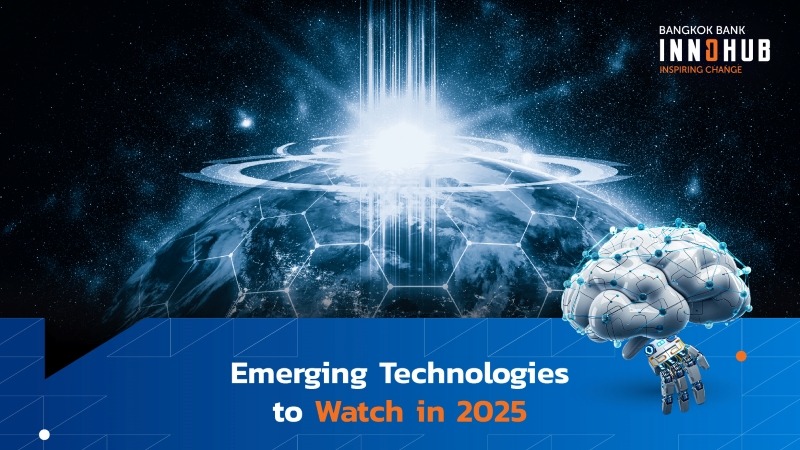Here at the quarter-century mark, virtually every action we take in today’s world is mediated by technology that was unknown to mass audiences in 1999. It’s getting hard to remember what everyday life was like just a generation ago, before smartphones, ride-hailing and food delivery apps, before social media chats, digital selfies, GPS-guided transport, on-demand TV and podcasts, generative AI, and a host of other conveniences. Even WiFi itself was just barely beginning to gain traction at the turn of the century.
What the coming 25-year stretch will bring is anyone’s guess, as the next 12 months alone promises great excitement. From gene editing and brain implants, all the way to the grandeur of space exploration, here are the top innovations to get excited about in 2025.
- Brain-Computer Interfaces (BCIs)
BCIs are advancing rapidly, with companies like Neuralink continuing human trials that enable direct brain-to-computer communication.
The global market is projected to grow at a CAGR of 17.8% from 2024 to 2030, powered by use cases such as medical rehabilitation and assistive technologies for conditions like paralysis. This technology promises to restore communication abilities and even mobility for people with severed brain or spinal connections.
- Generative AI
Key players like OpenAI, AWS, and Adobe are bringing new levels of efficiency to business applications, while also providing everyday AI assistance for ordinary people.
The generative AI market is projected to grow at a CAGR of 37.6% from 2025 to 2030, driven by advancements in multimodal capabilities and domain-specific models. Apple’s new ‘genmoji’ software, which provides custom emojis based on use prompts, is just the tip of the iceberg. Soon we will ask AIs to explain a concept, and they’ll create a tailored mini-podcast on the topic just for us. Customized, AI-generated videos, songs, and even shareable software will likewise become commonplace as this sector matures.
- Neuromorphic Computing
Companies such as Intel and IBM are at the forefront of the neuromorphic computing space, enhancing chip performance for specialized use cases like energy-efficient AI hardware.
This market is projected to grow at a CAGR of 19.9% from 2024 to 2030 due to increasing demand in autonomous vehicles, IoT, and robotics. As robots and self-driving cars enter into open-ended operation in the real world rather than in controlled environments, they will need to start processing information the way people do. After all, the world is designed for vision, not LiDAR; and for onboard inference, not centralized computation in a remote database warehouse. Neuromorphic computing lets AI chips process information and recognize patterns in a more human-like manner, operating locally and in real time while consuming less energy.
- Synthetic Biology
From Impossible Foods’ plant-based meat substitute, to Pivot Bio’s gene-edited microbes that deliver nitrogen efficiently to farmland, to Novartis’s accelerated drug development processes, synthetic biology unlocks faster biological innovation as well as the potential for personalized drugs.
The sector is projected to grow at a CAGR of 17.30% from 2025 to 2030, fueled by its potential to revolutionize the pharmaceutical, agriculture, and energy industries. Among the many economic implications of this technology, traditional supply chains face disruption as new biomanufacturing processes are developed by startups and academic institutions. At a more personal level, next-gen nanomaterials will be used to serve the human body, delivering drugs, healing wounds, and monitoring internal health.
- Space Commercialization
The commercial space industry is expanding, with private players like SpaceX and Blue Origin bringing orbit within reach for aspiring space research and tourism companies.
The global space economy is rocketing upwards at a 9% CAGR, giving it a value of $1.8 trillion by 2035. SpaceX’s recent successful catch of the Super Heavy booster with robotic arms enhances the feasibility and scalability of reusable rockets, a crucial aspect of reducing the cost of space access. Unusually for a company with an innovation-based business model, SpaceX patents very few of its designs, letting other companies follow its lead if they have the engineering skill to do so.
Although many entrepreneurs have said that they ignore space because “there’s nothing there”, new markets have opened significantly alongside the falling cost of space access. Starlink internet is proving to be a major hit around the world; governments are finding military uses for space; civilian satellites, such as for weather and GPS, are always in demand; space exploration (via both physical travel and telescopes) is gaining momentum, asteroid mining is becoming a realistic prospect, and some see Mars colonization as a genuine possibility later this century.
Choose your own adventure
These breakthroughs will affect us all differently. Perhaps space travel brings you only a sense of wonder and nothing more; perhaps you personally have no need for a brain-computer interface. For others around you, however, such advances could be life-changing.
Today’s businesses should think carefully about the implications of these new technologies, and adjust their strategies accordingly. Which products and services will be needed in our fast-approaching future? Which ones will be obsolete? How can tomorrow’s tech advances be modified for other creative uses?
Forward-looking companies can profitably ride the wave of technology even if they do not create it. Businesses that fail to look ahead, or adapt adequately to the disruption around them, will feel the impact of that same wave as it crashes into them. Technological change thus reshapes the business landscape, just as surely as it reshapes everyday life for people around the world.




